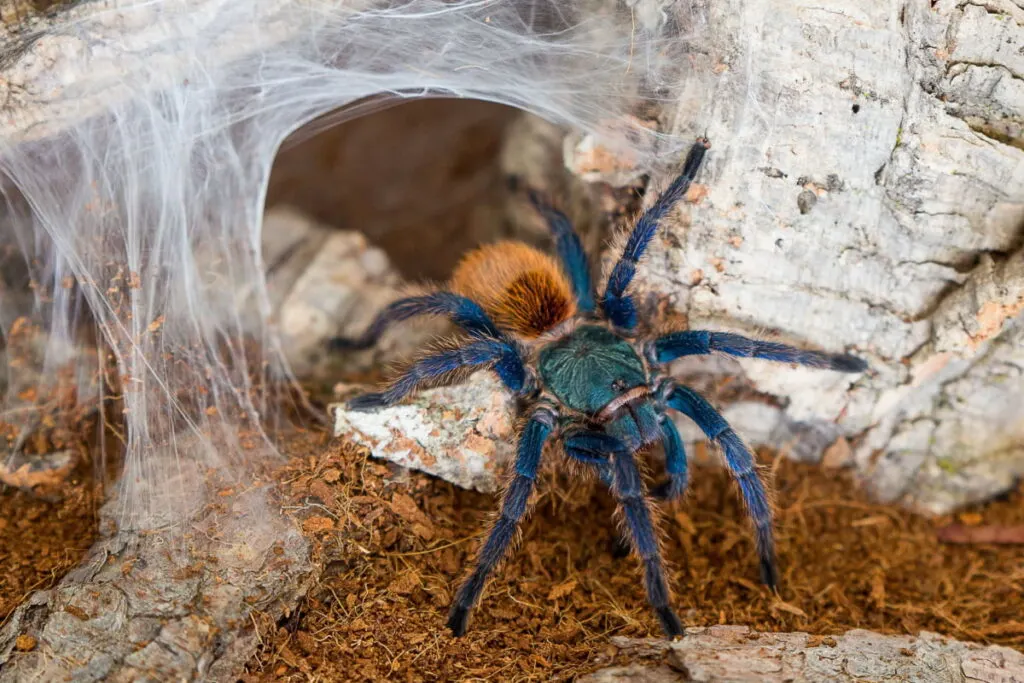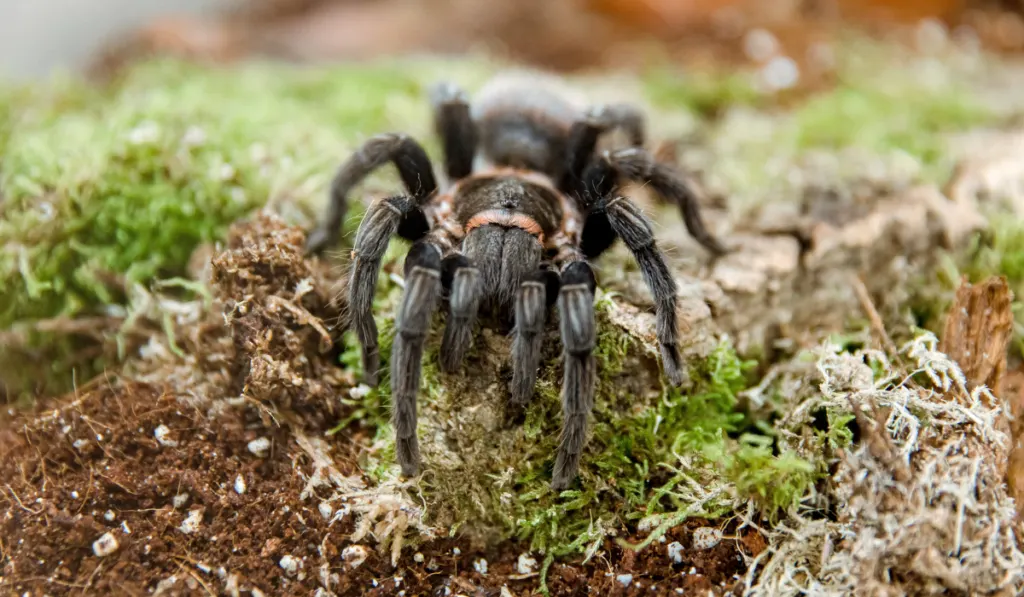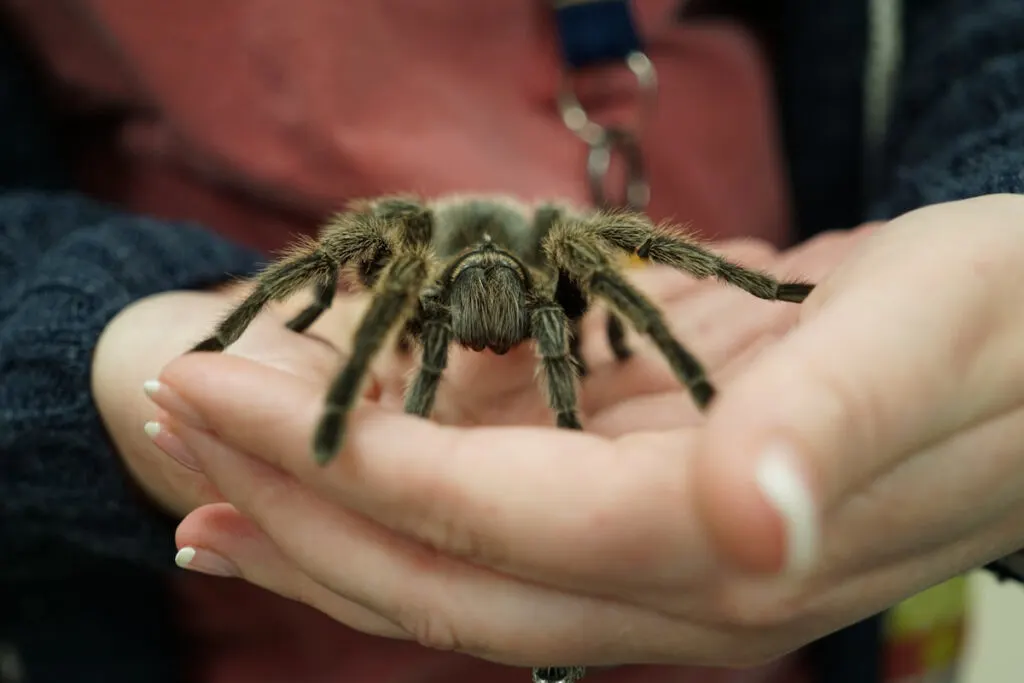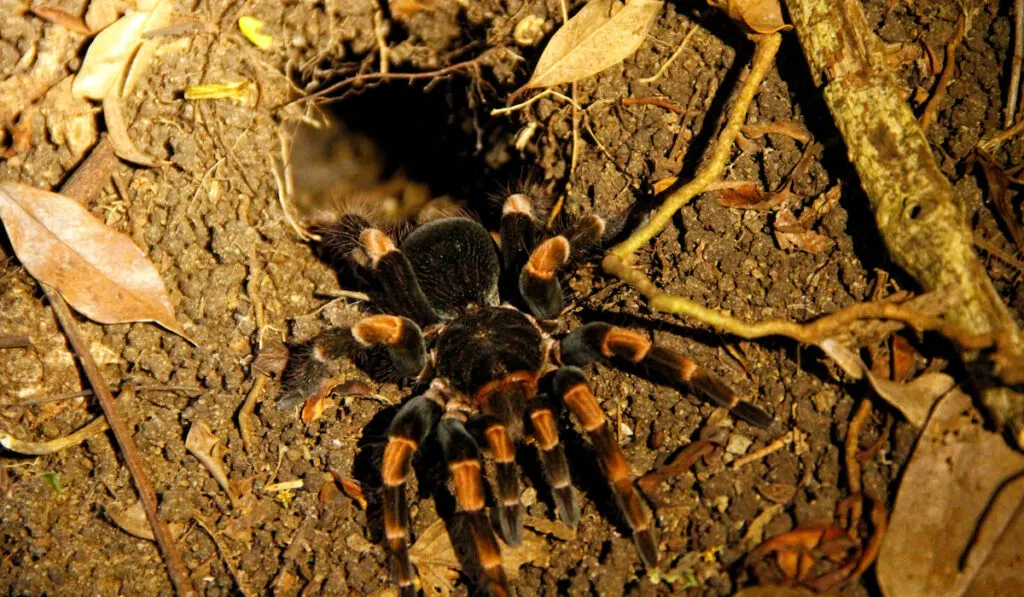Some types of frogs hibernate. As it gets cold, these frogs begin to slow down. They bury themselves deep into the ground, let the cold freeze them, and sleep until spring warms up the earth. They defrost, wake up and come back out into the world again.
Bears hibernate. They spend a period before hibernation eating 20,000 calories a day, gaining about thirty pounds every week. Then they curl up in a den they made out of a cave, hollowed tree, underneath rocks or logs and sleep, birth, and raise their young until they emerge in the spring.
All different types of animals, from turtles to squirrels to snakes to bumblebees hibernate. So, hibernation is a legitimate practice among animals. Personally, I would prefer it if it were a legitimate and accepted practice among human beings, but I digress.
The question is if it is a practice performed by mammals, by reptiles, amphibians, and bugs, could it also be possible for an arachnid to hibernate too?

Perhaps you have your own tarantula, and you’ve noticed that, like frogs, it’s started to slow down and become sluggish. Could it be preparing for hibernation? It may have stopped moving entirely, and be refusing food. Could it already be hibernating?
Read on to find out if tarantulas hibernate, along with a bunch of other cool and important facts about these unique creatures.
Table of Contents
My Pet Tarantula Is Barely Moving Anymore and Won’t Eat Anything. It’s Cold Outside: Could It Be Hibernating?
Well, we’ve got to address the question upfront before we move on to an explanation.
Do tarantulas hibernate?
The quick answer: no. Not in captivity, and not exactly. It is not part of their natural yearly cycle to prepare for and complete a hibernation process.
If kept in ideal (warm) temperatures, your tarantula would be active all the time. However, sometimes, when it gets colder outside or if it is not kept warm in its tank, the tarantula can start slowing down and looking like it’s beginning hibernation.
It’s all because of what type of creature arachnids are. They are cold-blooded, and as opposed to warm-blooded animals they need outside sources to provide them with warmth rather than making their own.
If they don’t get enough warmth, they’ll just stop moving. Heat brings energy, so without heat, the spider won’t have the energy to move anywhere.
But eating brings energy too, right? Why doesn’t it just eat? Well, in such a cold and unappealing environment the tarantula will have no motivation to find food, or it may not feel the need for it. Have you ever been outside (or inside) and it was so cold all you wanted to do was curl up in a ball and fall asleep? Or never move again?
Well, this is how the spider feels when the temperature drops. All it wants to do is curl up in a ball and wait for the warmth to come back. And that’s where you come in because the spider can’t make its own warmth– you’re going to have to help him!

I’m Sorry, Spidey! I Didn’t Know It Was So Cold For You! How Can I Fix This? Will He Ever Wake Up Again?
Don’t fret– he’ll be fine, and so will you! Don’t feel bad, either: you didn’t know any better, and you can’t blame yourself for something you didn’t know (if you did, though, shame on you!).
First of all, look at the situation. Is it wintertime? Is it chilly or even frosty outside?
Often, as it happens, when it gets colder outside it’ll get colder inside if you don’t combat it properly. You’ll notice if your heat isn’t turned up enough because you’ll be walking around your house in coats and fluffy slippers!
Well, if it’s too cold inside for you, it’s much too cold inside for your tarantula! A similar concept to testing the sidewalk with your own feet when walking your dog: if it’s too hot or too cold for you, it’ll be the same for their paws.
Check the thermostat. A tarantula should always be kept at least 68°F, or else she’ll start to go into that chilly sleep mode we’ve been talking about.

The best temperature is between 72° and 79°F, but at long as it’s 68° or above then your fuzzy friend should be fine.
Don’t overdo it, though– if they’re kept at 110° or above, they won’t just fall asleep, they will die! I’m sure you’d never turn your thermostat up that high, but other methods of heating a tarantula tank may make it that hot.
So the first option is a thermostat. If you like your home between 72° and 79°, then by all means keep it at that temperature and let your spider be kept at room temperature too. Get a thermometer inside of their habitat to ensure that the air circulating throughout the house is getting into their tank, too.
If you like your house kept hotter or colder than 72 to 79, you may think the solution is to get a heat lamp. Don’t! Heat lamps, heat rocks, heat pads, and mats will put too much concentrated heat on your tarantula, dry them out, and kill them!
Instead, if the room temperature isn’t sufficient for your spider’s welfare, get a space heater. Set it up in the same room as the tank. Set the temperature for between 72° and 79°, and there you go!
Just ensure that it’s always plugged in, and keep a thermometer in the tank when using a space heater as well to be able to check and make sure it is doing its job and keeping your spider nice and warm.
Whoever’s bedroom, or whichever room the tarantula is in is just going to have to have a space heater in it at all times. So get used to it.

Is It All Over For Your Spider If It’s Already Gone Into Sleep Mode?
No! If it’s kept at such a cold temperature for too long, then yes, it will die. You’ll have to be vigilant, because exposing your tarantula to temperatures lower than 50 degrees for an extended period can definitely kill them, and if not, certainly be harmful to their health.
But if you see your tarantula in sleep mode, check the thermometer and realize, ‘Oh no! It’s fallen down to 65!’ don’t stress too much. Just get the temperature up to the desired amount as quickly as possible, and give your spider some time.
They’ll need to come out of it slowly, so don’t think they’re dead if they don’t start moving after five minutes! Give it a while to wake back up and move around its cage again. It should be perfectly fine after a while, and may even be hungry for a snack!
What If It’s Not a Pet? What If I Just Want To Know If Tarantulas Hibernate in General?
Well, that changes the answer. A tarantula in captivity, bred and raised, should not hibernate. This is because you, as a responsible keeper, should be ensuring it is kept at a warm temperature and full of energy to be able to move around as it pleases.
However, a wild tarantula may go into sleep mode, called diapause, if the climate in its natural region gets too cold. It will stop moving to conserve energy by reducing its metabolic activity, and in not moving it can stay alive without food for quite a while.
Tarantulas naturally only eat once every two weeks, so in not moving it can have the energy to live for much longer. To conserve warmth, the tarantula will crawl into its burrow and plug up the entrance hole, hoping any lingering warmth will stay and keep it warm enough to stay alive. It will stay still enough that it can use its remaining energy to keep itself alive until it warms up and can move freely again.

Conclusion
Overall, it is possible but not common to see a tarantula hibernate. In the wild, it may be necessary in certain weather conditions, but that is rare. And if it’s in captivity, then the owner needs to check the thermostat or the thermometer in the spider’s tank because it must be cold enough that this survival mechanism is kicking in.
It’s a survival mechanism as a last resort, however, so it’s best to keep our tarantulas warm, happy, and dancing around their tanks!
Don’t stress about the temperature– you may now be terrified about your tarantula never waking up if you let the temperature drop. But it’s not as big a deal as you may think– just observe: when you come into your room, do you feel it’s a little chilly? If so, you’ll want to check the temperature and ensure your tarantula is safe. If not, there’s nothing to worry about.
